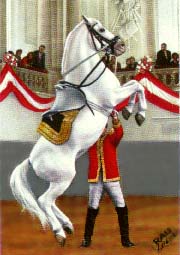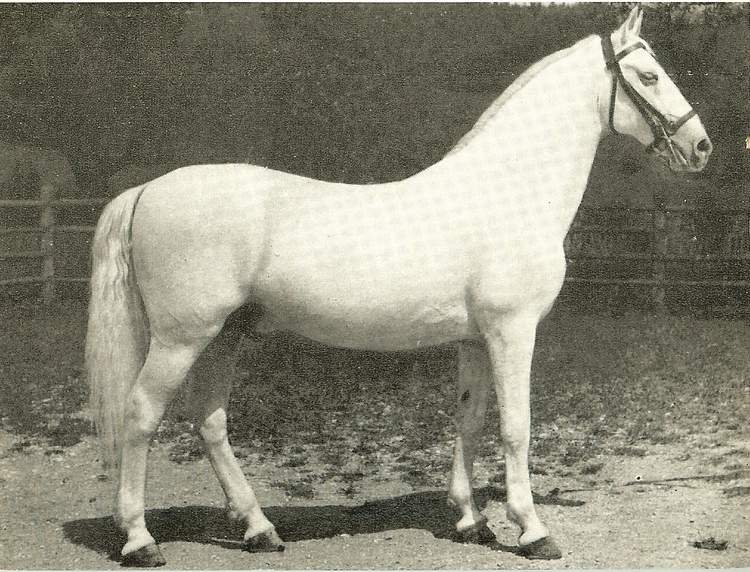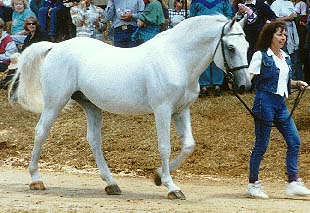

Lipizzaner


Introduction: Austria's famous breed, used by the Spanish Riding School in Vienna. I have seen these horses perform; they are awesome! If you have any comments or suggestions, please click here. The painting on the left is beautiful, accurate to the best of my knowledge, and one of my favorites, as it displays one of the most beautiful airs above the ground--the courbette, made famous in Marguerite Henry's White Stallion of Lipizza. The photograph on the right, however, has special significance: It is of the Lipizzan stallion Maestoso Alea, ridden by Colonel Podhajsky himself.
Names: Lipizzan, Lipizzaner. Named after the place (actually in Yugoslavia) where the original stud was. I will probably use the shorter name more.
Origin: Lipizzans are usually associated with the Spanish Riding School in Vienna, but the breed originated in the Karst region of north Yugoslavia, where the Archduke Charles established a stud at Lipizza in 1580. They are now bred at the Austrian National Stud at Piber, close to the Yugoslav border, and are considered an Austro-Yugoslav breed that is also bred in Hungary.

Mares and foals at the Piber Stud
Foundation stud at Lipizza near Trieste, now (1960s) Yugoslavia, founded 1580. Stud Piber near Koflach, Austria. Studs at Babolna Kisber, Gyongyos, Szilvasvarad in Hungary. In addition there are the Yugoslav studs at Kutjevo, Lipik, Fruska Gora, Prujavor, Dobricevo. Breeding in all three countries is almost exclusively State-controlled. The Yugoslav Lipizzaners are generally dar, as they are widely used in agriculture.
Breeding: The
Archduke Charles used Spanish Andalusian-Barbs,
a legacy of the Moorish invasion, horses of particular courage and substance,
allied to dramatic beauty. Other blood, including Arab, has been
introduced, plus a policy of line and selective breeding. Now
the Piber Lipizzans are of recognizably different strains, but all share the
outstanding features of their breed.
The Lipizzaner is descended from three roots, the Spanish
horse, the Karat (Karst?) horse and the Arab.
When Spain was conquered, all the valuable Iberian horses, famed from time
immemorial, fell into the hands of Ferdinand of Aragon--as did the breeding of
horses based on the Barb
and hitherto carried on by the Moors. These breeds
met the requirements of that period for a light, mobile war-horse to replace the
heavy tournament horse of the knights, after the invention of firearms, and made
a triumphal entry throughout Europe. In 1580, Archduke Charles founded the
Lipizza Stud at Trieste in the Kurst region. By improving the ancient
breeds of fairly heavy local horses (which the knights used as tournament
horses) with Spanish stallions, five of the six Lipizzaner strains were
originated through Pluto, Conversano, Maestoso, Favory
and Neapolitano. These sires came from the most famous studs of
that time in which Spanish horses were being bred--Naples and Frederiksborg.

Lipizzaner stallion Pluto V
Later a sixth strain was added by introducing an Arab
stallion, Siglavy, which bears strong Oriental
characteristics. Besides tihs, all the other strains, with the exception
of the Pluto strain, were given a fresh blood admixture by crossing in Arabs
. The Incitato strain bred in Hungary and Yugoslavia
is, in general, dark coloured, and reminds one even today very strongly of the
old Karst (Karat?) horse. Since the foundation of the Spanish Riding
School in Vienna in 1735 by Charles VI there has been continuous training of
horses in the "lessons" of the High School. Only the best horses
are used in breeding for this training.
A rule that I believe still holds true for all Lipizzaner
stallions, but certainly for those used in the Spanish Riding School, is that
each stallion has two names--the first name being that of his strain, and the
second that of his dam. For example, Maestoso Borina was a stallion of the
Maestoso strain whose dam was named Borina, and he too was called by that
name. (This information is taken from White Stallion of Lipizza, and I
hope to be able to research further to what degree this custom is still
followed.)
Description: (In place of a general description, I couldn't resist including this lovely picture, to which you can refer to study the conformation.)

Action: Relatively short step in walk; springy trot with high knee action, which makes the Lipizzaner particularly suited to the Spanish Passage. Gallop rather cumbersome and covering little ground.
Body: Rather stocky and well-built. Short, thick, arched neck, strong and set on rather high. Broad chest. Shoulders often a little steep. Not very prominent withers. Long, muscular back with strong loins. Strong, rounded quarters. Tail well set on and beautifully carried. Strong bones.
Color: The stallions that perform haute école in Vienna are all born black or brown, turning gray and then white as they age, but there are also bay and chestnut Lipizzans. Grey predominating colour (completely white by ten years of age). Exceptionally bay (Yugoslavia), often mealy chestnut.
Hair: Mane and tail with thick, fine hair.
Head: Heavy and rather big, with fairly prominent Roman nose. Large, expressive eyes. Small ears, well placed.
Hooves: Small, perfectly-formed, hard.
Legs: Short, strong, hard, with clearly marked tendons and joints. No hereditary joint weaknesses such as spavin or thoroughpins, etc. Sometimes the forequarters a little faultily placed.
Size: They vary in height from 14 to 16 hands. 15.2 to 16.2 hands.
Temperament: Intelligent and docile.
Features:
They
mature late but are long lived. They are economical to keep, and are active
workers with an inherent obedience. Outstanding stamina, looks, and
temperament.
The High School horse par excellence. His intelligence,
exceptional ability and willingness to learn, his absolutely reliable character,
his almost complete lack of vices, as well as his conformation--especially his
innate high knee action--qualify the Lipizzaner, above all other breeds, for
High School training of the Airs on and above the ground. The mares are
also suitable as light, elegant carriage horses. The Yugoslav Lipizzaner
is an excellent and enduring draught horse, easily looked after.
Relatively late in maturing--at about the age of seven years--but long-living.
Uses:
Excellent
dressage horses, they are also especially good in harness. A four-in-hand of gray
Lipizzans would be hard to beat for their good looks and driving potential.
In the Middle Ages, Lipizzans were another of those breeds,
all closely related, which were much prized as parade and battle horses.
They have always been popular for carriage and circus work, and they also make
excellent riding horses.
Although Lipizzans make particularly impressive ceremonial horses, they are
also admirable for all kinds of farm work--and appreciated in this role by the
small farmers, especially in the north and northwest of the country where the
majority of Lipizzans are found.
Accomplishments: Best known for performing the highly controlled and intricate movements of haute école in the world-famous Spanish Riding School at Vienna.
Curiosities: It
takes from three to five years to train a horse to the superlative standards of
Vienna and even longer for a man to become qualified as a Bereiter (riding
master). Built in the 16th century, the School was originally used for
teaching the sons of royal and noble blood. From those days only white
stallions have been used. Although the spectacular airs of haute école
may appear artificial, they have evolved from movements that enhance the
impressiveness and safety of the rider on parade and in battle, such as capriole,
when the horse leaps high in the air, lashing out with its powerful hind feet.
In Yugoslavia
the many virtues of these horses have been
appreciated for a very long time. Centuries before, the Greeks also
thought highly of this breed, and on the Parthenon frieze now in the British
Museum one is reminded of the Lipizzaner performing "high school" movements.
Profiles:
Conclusion: